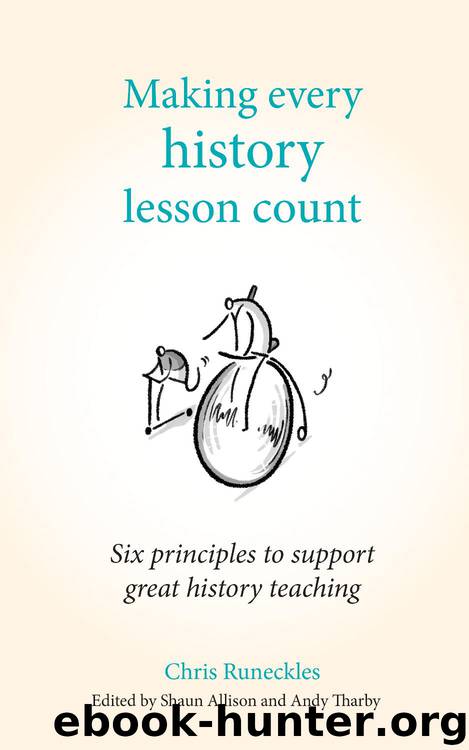Making every history lesson count by Chris Runeckles

Author:Chris Runeckles [Chris Runeckles]
Language: eng
Format: epub
ISBN: 9781785833793
Publisher: Crown House Publishing
Published: 2018-02-10T16:00:00+00:00
The other element for us to consider is purposeful practice. This is perhaps the more concrete side of how our students practise in lessons. This is how we stretch and challenge our students and push them to the outer reaches of their capability. In doing so, we develop their ability to use what we teach them without our input. The subtlety with purposeful practice lies in knowing how much involvement to have with it as the teacher. This is shown by the continuum on page 79.7
Knowing where you are on this continuum is dependent on the class and the individuals you are teaching, as well as on the topic. Through experience you might know that you can release your grip sooner when attempting to build knowledge and understanding of Mary I’s approach to heretics as opposed to Elizabeth I’s approach to the poor. Additionally, your methods would be different for an Evie compared to an Edima.
There is also a further division of purposeful practice in history: how we develop students’ competence with the knowledge we teach them and how we aid their historical writing. The two are interdependent but do not necessarily develop proportionally or congruently in all learners. We can all picture the student who can confidently tell us all about the four humours in ancient Greek medicine, but ask them to write a paragraph of explanation and it will appear that they have only the flimsiest understanding. Equally, we encounter students who write in exactly the manner we require but consistently demonstrate a lack of conceptual understanding of the history they are writing about. Logically, the chronology of purposeful practice has three stages in history:
1 Practise with the knowledge by rehearsing and testing it. For example, work through the causes, key features and consequences of the Berlin Blockade. Focus on common misconceptions, such as confusion with the Berlin Wall and the position of Berlin behind the Iron Curtain.
2 Practise critical thinking by rolling our new knowledge around and forming opinions and judgements. For example, who was to blame for the blockade beginning? Why was this different to all the events in the Cold War up to this point? Why was Berlin always destined to be a Cold War flashpoint? Why was the world a more dangerous place after the blockade ended?
3 Practise applying the knowledge through writing. For example, explain why Stalin began the blockade of Berlin in 1948. Write a narrative account of the Berlin Blockade. Explain two consequences of the Berlin Blockade.
Download
This site does not store any files on its server. We only index and link to content provided by other sites. Please contact the content providers to delete copyright contents if any and email us, we'll remove relevant links or contents immediately.
The Art of Coaching Workbook by Elena Aguilar(50155)
Trainspotting by Irvine Welsh(21063)
Twilight of the Idols With the Antichrist and Ecce Homo by Friedrich Nietzsche(18314)
Fangirl by Rainbow Rowell(8812)
Periodization Training for Sports by Tudor Bompa(7939)
Change Your Questions, Change Your Life by Marilee Adams(7397)
This Is How You Lose Her by Junot Diaz(6469)
Asking the Right Questions: A Guide to Critical Thinking by M. Neil Browne & Stuart M. Keeley(5378)
Grit by Angela Duckworth(5314)
Red Sparrow by Jason Matthews(5215)
Paper Towns by Green John(4819)
Room 212 by Kate Stewart(4755)
Ken Follett - World without end by Ken Follett(4461)
The Sports Rules Book by Human Kinetics(4089)
Housekeeping by Marilynne Robinson(4078)
Double Down (Diary of a Wimpy Kid Book 11) by Jeff Kinney(3947)
Papillon (English) by Henri Charrière(3935)
The Motorcycle Diaries by Ernesto Che Guevara(3798)
Exercise Technique Manual for Resistance Training by National Strength & Conditioning Association(3794)
